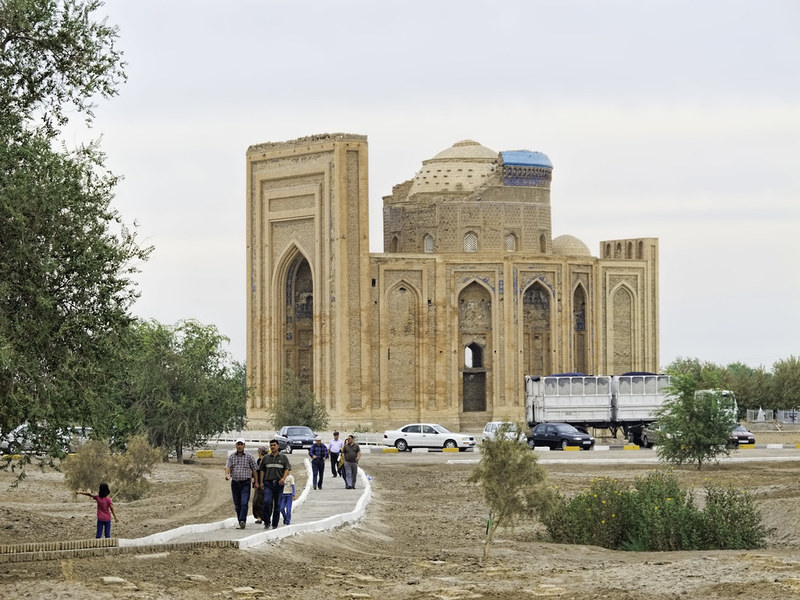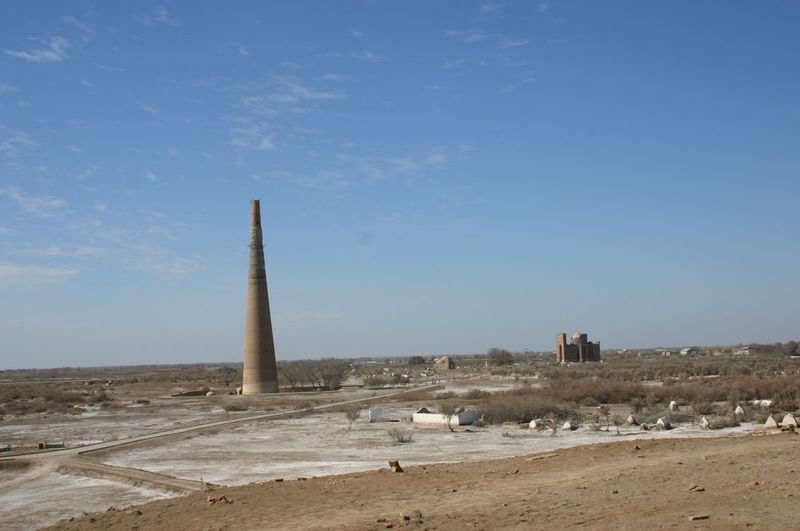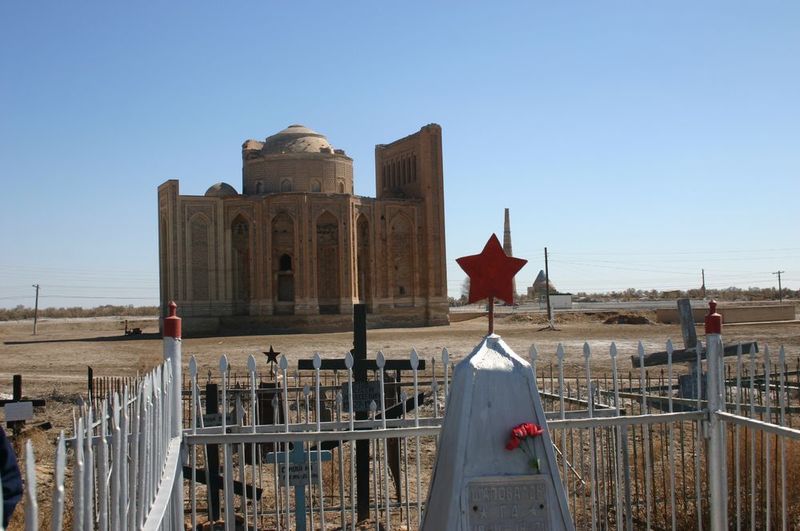Konye-Urgench is a beautiful city in the far north of Dashoguz Province in Turkmenistan.
Konye-Urgench,
Turkmenistan
We take a look at all you need to know on Konye-Urgench. How to visit, the history, and highlights of Konye-Urgench.
Feel free to skip to the relevant chapter below!
Konye-Urgench Introduction
History of Konye-Urgench
Highlights of Konye-Urgench
How to Visit Konye-Urgench
Konye-Urgench Introduction
Konye-Urgench; UNESCO-listed site.
Turkmenistan is one of those places which is both new and old.
It achieved independence only in 1991 from the USSR, following a century of Russian dominance.
Yet, through the millennia, some of the greatest civilisations have either existed on her land or passed through the endless paths of trade and war.
Some of the relics left behind by these empires still exist.
One of the very best places to go and visit, in particular, is the UNESCO-listed site of Konye-Urgench.
Konye-Urgench is situated in the far north of Turkmenistan, Dashoguz province. It is just a few kilometres away from the border with Uzbekistan.
Konye-Urgench History
Founded probably sometime in the 5th Century BC, Konye-Urgench grew to become the capital of the state/region of Khorezm.
Different Empires
Khorezm was part of the larger Achaemenid Empire. Persia, basically. The then-largest empire the world had ever seen.
Alexander (the Great) and his lads came through. This made this part of the Seleucid Empire.
It changed hands a few more times but remained an important bit of urban area to hold onto for any aspiring regional bossman.
Arab Invasion
Things lasted this way until the Arab invasion in the 8th Century which swept all before it and introduced Islam to the region too.
Silk Road
Konye-Urgench then became more prominent in the days of the Silk Road as communications and trade lines became more viable and crisscrossed Central Asia.
This brought wealth and proto-globalisation to the region.
Genghis Khan
With wealth and influence come jealous eyes though.
Konye-Urgench was sacked and destroyed by successive giants of the region.
Genghis Khan’s Mongol Horde showed up in 1221.
The Mongol army demanded surrender. This was met with a polite no and promptly used the dam which irrigated the area as a weapon of war.
This flooded the city and then predictably massacred most of its inhabitants.
Konye-Urgench staggered back to its feet though.
Timur
Ibn Battuta was very complimentary about its beauty and value when he visited.
But he was a little too early to be there when Timur showed up. He razed the city (apart from the bits that were too hard even for him to raze), flooded it again, and built a pile of skulls.
He also made off with all the artisans, craftsmen, and academics he admired and they got new jobs at the court or Timur in Samarkand.
This was more or less the final blow for the peak era of Konye-Urgench.
The Fall od Konye-Urgench?
Once their predecessors have become part of a pile of skulls, it is hard to attract the philosophers, architects, and professors to come back again.
The irrigation system was done for. The buildings were almost all gone. Timur had planted Barley in all the good land, thus ruining it for other crops.
While people remained living here until the 1700s, the glory days were over.
The city had become presumably just a place where locals complained about how they used to be the jewel of the Silk Road while munching their morning Barley.
Konye-Urgench means literally ‘old Urgench’.
A new city named Urgench was built and people moved there.
It is in present-day Uzbekistan.
The site we know and love fell into even more disrepair until archaeological work began in the 1920s
It continues to this day.
Konye-Urgench Highlights
Konye-Urgench is a large area. Nevertheless, is still very much walkable.
Despite being ravaged by some of the great ravagers, there are still significant ancient structures extant.
Here are a few of the highlights of Konye-Urgench you should be sure to get to.
Mausoleum of Turabek-Khanum
The car park is here so you will probably do this site first.
And rightly so, as it is a stunning way to start the visit.
Turabek-Khanum was the wife of local leader Gutlug-Timur and this is her final resting place.
It is still a site of pilgrimages from local people, especially women.
Architecturally, the defining feature is the double-dome. Something possibly innovated here in the 1330s.
Sadly most of the outer dome has collapsed. But the general idea of it is clear to see.
The inside of the inner dome is simply a stunning piece of mosaic art which is perfectly realised and lends itself to great photos.
The multiple windows and angles inside the main chamber all denote various seasons of the year, months and so on.
A detailed explanation can be given by any competent guide on the spot.
This is one of the great buildings of its era and not something that history buffs will want to miss.
Gutlug-Timur Minaret
You will see this from many miles away before arriving at the site.
It is by far the largest monument in the area
At over 60m tall, it is a true marvel of medieval engineering.
Its origins are unclear. But the current name it takes is that of its restorer (in the 1330s). The original building was much older.
There is no mosque attached to the minaret and thus there is disagreement as to its original function. Religious in nature? Or a lookout tower? Perhaps both.
Mausoleums of Najm ad Din al-Kubra, Sultan Ali, and Piryar Vali
In the middle of the site, this cluster of smaller tombs stands out.
There is the tomb of a regional ruler (Ali), master of Chess and Sufi founder (al-Kubra), and one of Kubra’s friends (Vali). These tombs draw in pilgrims and tourists.
It is architecturally distinct and impressively constructed, as well as religiously significant for many people.
Mausoleum of Sultan Tekesh
Founder of the Khorezm Empire and ruler from 1172-1200.
This mausoleum has various unique features that can be pointed out on the spot.
From its conical dome to the beautiful niche above the entrance.
It probably stood as part of a cluster of administrative buildings before the destruction of all the others in one of the various invasions.
The blue tiles on the conical dome are striking and original and give a sense of what it was once like.
Kyrkmolla
This is now basically a big mound of earth, sadly largely roped off from visitors.
When it was possible to explore more deeply here you would find bones sticking out from the ground and a huge array of small piles of stones left by locals making wishes at this place.
Women hoping to become pregnant also come here to this day to roll down the hill and leave small dolls to mark their wishes.
This was once part of a mighty fortress and a wall to emulate how it may have looked at that time has been partially built on one side of it.
The name of this site means “40 Mullahs”.
Local legend has it that these pious religious scholars were concerned with the priceless texts that were in their library on this site.
When the Mongol invasion of the city began they prayed with such virtue and passion that Allah heard them and flipped the library over, burying it and the martyrs forever. But eternally protecting the manuscripts from the infidels.

How to Visit Konye-Urgench
The nearest city and airport in Turkmenistan is Dashoguz, around 90 minutes away on fairly decent roads.
Konye-Urgench is also close to the Uzbekistan border.
A trip to either Nukus or Khiva can be done in just a few hours. This includes the border crossing.
You can consider it as an option to start or finish a trip to Turkmenistan.
The nearest hotels are in Dashoguz as there are no overnight options onsite at Konye-Urgench.
See our guide to Dashoguz for options in that city.
Koryo Tours
Turkmenistan Tours
Turkmenistan Travel Guide | Sign up to the mailing list | About Koryo Tours

